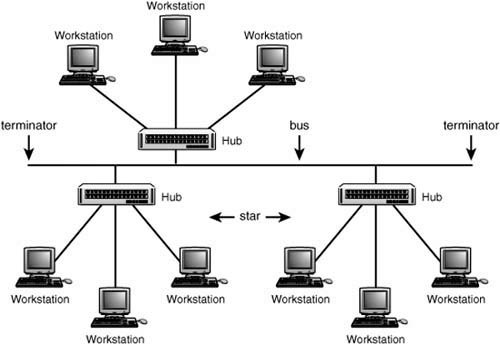Hybrid LAN Topologies
| Switches and hubs are simple methods for creating small workgroup LANs. By using structured wiring methods, it is easy to connect hubs and switches to create larger LANs. Two popular methods used to do this are the tree and the hierarchical star. TreeFigure 13.3 shows a combination topology that groups workstations in a star and joins the stars along a linear bus. Most of the problems of the bus are eliminated because a single workstation cannot bring the entire LAN to a halt. You can still add or change workstations by plugging them into different ports on the same hub/switch, or on another device. Intelligent hubs and switches are capable of isolating misbehaving ports. Some do this automatically, whereas others require management intervention. Figure 13.3. The tree topology connects star formations along a linear bus. This is an inexpensive method that can be used to join different work departments in a building. Each local workgroup can have an administrative person who is responsible for managing the connections on the local hub or switch. The network administrator can regulate when and where new wiring concentration devices are attached to the network. The major problem with this type of hybrid topology, however, is that if there is a problem with the backbone bus cable, in a tree topology, the network becomes segmented into individual hubs or switches. Workstations on each local device can communicate with each other, but data transfers through the network to workstations on other hubs or switches will be disrupted until the cable problem is diagnosed and corrected. Hierarchical StarAnother method that can be used to connect hubs/switches is a hierarchical star. This method, shown in Figure 13.4, uses a central hub or switch to link other similar devices that have workstations attached. Figure 13.4. Hubs and switches can be used to form hierarchies of star networks. This method can be used to attach up to 12 hubs to a central hub, creating a large LAN. Without using a bridge, you can connect as many as 1,024 workstations into a LAN using this method. Remembering the 5-4-3 rule, there can be up to five cable segments, connected by up to four repeaters in the path between any two nodes in the network. When working within coaxial cablebased networks such as 10BASE-2 and 10BASE-5, only three of the five cable segments can be used for computers; the other two must be used to link repeaters. Of course, if you are using switches instead of hubs, you can extend the size of your LAN to a much greater size. The 5-4-3 rule is a requirement of legacy hubs which create a collision domain that includes all the attached computers. Switches reduce the collision domain so that there is no contention for the network media on a particular LAN segment. Keep in mind, however, that communications between switches can be a limiting factor, because the link between two switches is shared by all ports on the connected switches. Computers attached to each switch can transfer data using the full bandwidth for the particular type of Ethernet used, such as 10Mbps or 100Mbps. However, when nodes are separated by two or more switches, the bandwidth through the switch interconnections is a limiting factor, because more than one communication session can be happening at the same time between the switches. |
EAN: 2147483647
Pages: 411
